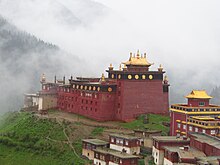| Palpung Monastery | |
|---|---|
 View of Palpung Monastery in 2014 | |
| Religion | |
| Affiliation | Tibetan Buddhism |
| Sect | Karma Kagyu |
| Location | |
| Location | Babang, Dêgê County, Garzê Tibetan Autonomous Prefecture, Sichuan, China |
| Country | China |
| Geographic coordinates | 31°38′54″N 98°47′45″E / 31.64833°N 98.79583°E |
| Architecture | |
| Founder | 8th Tai Situ |
| Date established | 1727 |
| Protected 1958. Reopened as monastery in 1982. | |

Palpung Monastery (Tibetan: དཔལ་སྤུངས།, Wylie: dpal spungs dgon pa[1]) is the name of the congregation of monasteries and centers of the Tai Situpa lineage of the Kagyu school of Tibetan Buddhism as well as the name of the Tai Situ's monastic seat in Babang, Kham (modern Sichuan). Palpung means "glorious union of study and practice". It originated in the 12th century and wielded considerable religious, political, and economic influence over the centuries.[2]
The current monastery was founded in 1727[3][4] by the 8th Tai Situpa "Situ Panchen" with the great support of the Dharma King of Derge Temba Tsering. It is the seat of four lines of incarnate lamas, the best-known being the Tai Situpa[5] as well as the Jamgon Kongtrul and the Second Beru Khyentse. The temple has historically been associated with the Karmapas: for instance, Rangjung Rigpe Dorje, 16th Karmapa, was enthroned first at Palpung before traveling to his main seat at Tsurphu Monastery in Ü-Tsang.
The 12th Tai Situpa, Pema Tönyö Nyinje, has established a new monastic seat in exile at Palpung Sherabling Monastery in the state of Himachal Pradesh near the city of Baijnath. Palpung Yeshe Rabgyeling Nun Monastery is near the city of Manali in the town Bunthar about 3 hours drive from the Palpung Sherabling Monastery (Wylie: shes rab gling[6]).
- ^ "dpal spungs dgom pa". Tibetan Buddhist Resource Center. Tibetan Buddhist Resource Center. Retrieved 21 May 2015.
- ^ "History of Palpung Monastery". Archived from the original on 2008-08-28. Retrieved 2008-10-28.
- ^ "Palpung Centre History". Retrieved 11 November 2010.
- ^ "Kagyu Lineage". Archived from the original on 30 October 2010. Retrieved 11 November 2010.
- ^ "Palpung Architecture Project". www.asianart.com.
- ^ "shes rab gling". Tibetan Buddhist Resource Center. TBRC. Retrieved 21 May 2015.
